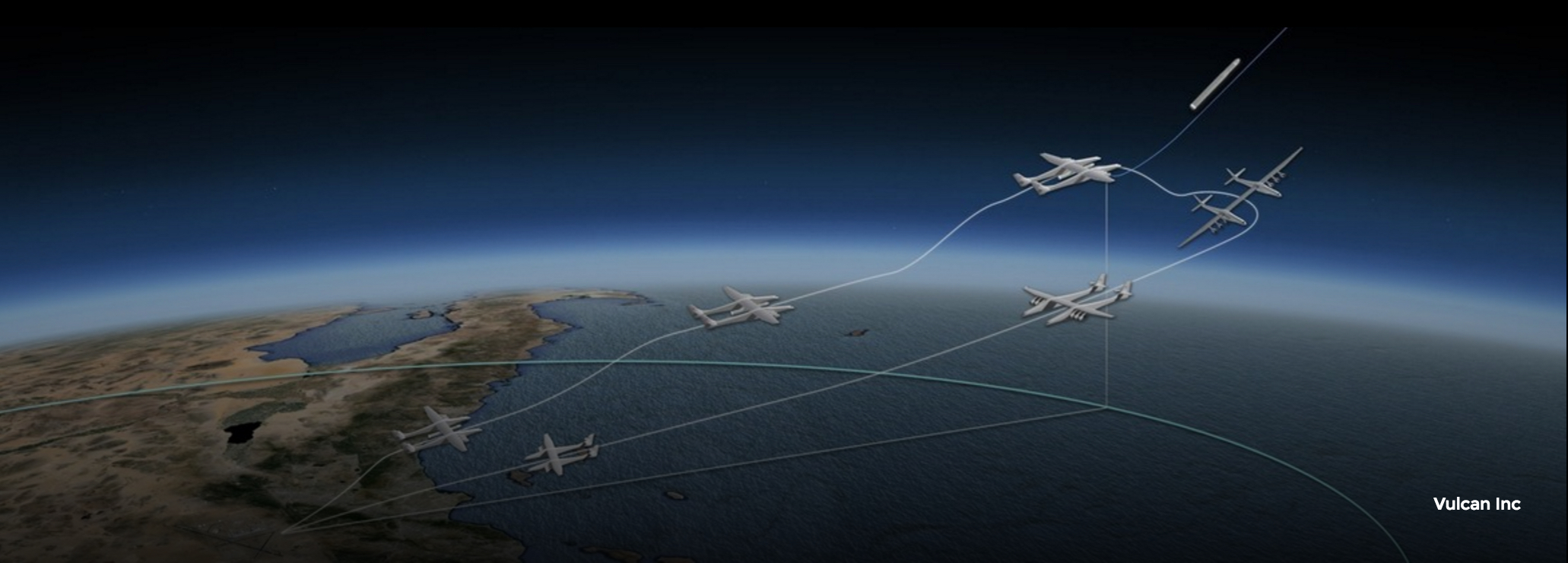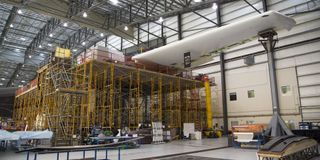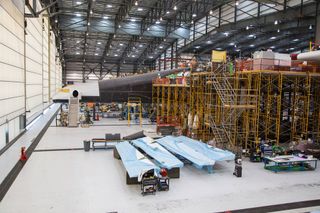World's Largest Plane Will Launch Rockets into Space

The way Paul Allen sees it, the bigger the better, at least when it comes to building an airplane to serve as a flying launch pad for sending satellites into space.
The airplane, informally called the "Roc" after the legendary giant bird of prey, is nearing completion inside a custom-built hangar at the Mojave Air and Space Port in California. It's the same place where the Roc's little sister, White Knight, lofted the SpaceShipOne spaceplane into the air in 2004 to clinch the $10 million Ansari X Prize for the first privately funded, manned vehicle to travel beyond the atmosphere.
RELATED: Lesson of SpaceX Rocket Landing: Try, Try, Try Again
Allen, a co-founder of Microsoft, whom Forbes ranks as the 40th wealthiest person in the world, with a net worth of about $17.5 billion, was the financier for White Knight and SpaceShipOne, which were designed and built by Burt Rutan and his company, Scaled Composites (now owned by Northrop Grumman.)
So far, White Knight has two direct descendants, both built by Scaled: White Knight Two, a carrier aircraft for Virgin Galactic's passenger suborbital spaceship; and the sprawling, twin-bodied Stratolaunch jet, which is designed to air-launch rockets and satellites with a combined weight of up to 550,000 pounds.
WATCH VIDEO: How Astronauts Deal With the Unhealthy Space Environment
White Knight Two will be used to fly Virgin Galactic's six-passenger, two-pilot SpaceShipTwo to an altitude of about 50,000 feet, where it will be released for an independent rocket ride beyond the atmosphere. Passengers, who will pay about $250,000 to fly, will experience a few minutes of weightlessness and see Earth set against the blackness of space from an altitude of about 62 miles, or 100 kilometers.
Get the Space.com Newsletter
Breaking space news, the latest updates on rocket launches, skywatching events and more!
RELATED: Virgin Galactic Taking On Satellite Launching
Paul Allen has a different market in mind. In an exclusive interview, Chuck Beames, who oversees Allen's space projects as president of Vulcan Aerospace, now says that flying paying passengers was never in the cards.
"There's no intention for any kind of space tourism … That is not in our plan today," Beames said.
Instead, Vulcan Aerospace intends to make money by delivering a variety of satellites into orbit, with particular emphasis on the planned low-Earth orbiting constellations designed to provide global Internet services, imagery, climate data and other remote sensing services.
Beames didn't rule out human spaceflight entirely, but said that passengers would be limited to test pilots and researchers.
Exactly how people or payloads will make it into orbit after being ferried into the sky by the Stratolaunch plane has not yet been announced.
RELATED: Skylon Spaceplane: The Spacecraft of Tomorrow
Initially, Stratolaunch sized the massive aircraft so that a version of SpaceX's Falcon rocket could loft mid-sized satellites into orbit. When that arrangement fell through, Stratolaunch turned to Orbital Sciences, now known as Orbital ATK, for a booster rocket.
Stratolaunch also mulled flying a scaled-down version of Sierra Nevada's winged Dream Chaser spaceplane. That plan, said Beames, is "on hold at best."

Instead, Stratolaunch now intends to partner with several rocket companies, rather than hire any one as a subcontractor.
Though the company's business plans have shifted since the project's unveiling in 2011, Beames said that if Allen was starting from scratch today he would still want to build the enormous airplane so that it could accommodate the widest range of payloads, everything from constellations of shoebox-sized Cubesats to mid-sized satellites weighing hundreds of pounds.
With a 385-foot wingspan, the plane is wider than the length of a football field and measures 238 feet from the tips of its twin noses to the multi-part empennages, or tail sections, in the rear.
The plane is bigger than Howard Hughes' famed "Spruce Goose," a Hughes H-4 Hercules that flew just once in 1947, and the Antonov An-225, a Soviet-era cargo plane originally built to transport the Buran space shuttle that is currently the world's largest aircraft.
RELATED: Dream Chaser Space Plane to Launch From the Stratosphere
Technically, the Antonov will still be heavier, but that is because the Stratolaunch plane is made of lightweight composites. The plane also includes engines, landing gear, cockpit and other parts from a pair of Boeing 747 jets purchased from United Airlines.
Like a 747, the Stratolaunch plane is designed to be operated by a three-person crew: pilot, co-pilot and flight engineer, with a jump seat available in the cockpit for a fourth person.

Beames won't say how much the plane cost to build or how much money Allen, the sole investor, has contributed.
"I lot of this is a vision thing … it's the Paul Allen idea man that this is where the world needs to go because the technology is moving in that direction," Beames said.
"I think that access to space is going to change the way we live and it's going to continue to change for decades into the future. The only limit is going to be the cost and convenience of access to space and each company has its own idea of how to do that," he added.
The Stratolaunch airplane is about 75 percent complete. Beames said he is optimistic the plane will be finished by the end of the year. Test flights will follow, with commercial operations expected to begin before 2020.
Originally published on Discovery News.
Join our Space Forums to keep talking space on the latest missions, night sky and more! And if you have a news tip, correction or comment, let us know at: community@space.com.

Irene Klotz is a founding member and long-time contributor to Space.com. She concurrently spent 25 years as a wire service reporter and freelance writer, specializing in space exploration, planetary science, astronomy and the search for life beyond Earth. A graduate of Northwestern University, Irene currently serves as Space Editor for Aviation Week & Space Technology.